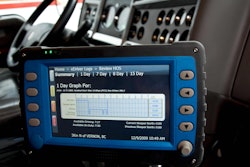The Internet, wireless networks and mobile devices have revolutionized how people, businesses and governments operate. These technologies are also disruptive, and even destructive, at times to companies and even entire industries that once seemed indomitable.
A recent announcement by the Federal Motor Carrier Safety Administration showcases one of many ways the technologies are changing the trucking industry. As of July 8, FMCSA permitted the use of wireless mobile data devices (smartphones, tablets, onboard computers, etc.) for use as transponders in electronic truck inspection and weigh station bypass systems.
This new wave of transponders can be used to identify motor carriers on highways as their vehicles approach inspection stations. Triggered by GPS signaling, the devices will communicate through wireless networks and the Internet to electronic screening systems that will issue the traditional red light/green light responses to the driver.
In anticipation of this change, Drivewyze launched a truck inspection and weigh station bypass service in August of 2012. The service combines a cloud-based software system used by law enforcement with a mobile app used by truckers. The company’s goal is to have nationwide coverage for its mobile bypass system which is already active in 16 states with agreements in place with four more.
“Our goal is to bring new a state online every month,” says Brian Mofford, vice president of technology.
At first glance, the announcement might seem disruptive to PrePass technology which is the de facto standard for electronic bypass systems. While not the only system used by states and motor carriers, it is by far the largest. Thirty one states and more than 450,000 vehicles use PrePass technology from HELP, Inc. to keep commercial traffic moving at highway speeds across state borders.
PrePass and other transponders in use today emit an identification signal through dedicated short-range communication (DSRC). Prior to FMCSA’s recent announcement, only DSRC-enabled transponders satisfied the agency’s requirement for electronic inspection systems if states were to receive federal funding.
With the change in technology, will the trucking industry begin a revolution in electronic bypass technology?
Karen Rasmussen, chief executive officer of HELP, Inc., sayst that PrePass has had the capability to use mobile data devices as transponders for “quite some time.” Based on feedback from states and motor carriers, PrePass has opted to not deploy the technology. The accuracy, reliability and privacy of data sent from mobile devices is suspect, she says. Motor carriers like the assurance of using a DSRC transponder. The signal can only be used by law enforcement for inspection purposes and is virtually foolproof.
“You know that the signal you are reading is from that of a truck,” she adds. By comparison, a truck driver could be targeted for inspection by emitting a signal from his cell phone while traveling across state lines in a personal vehicle.
Drivewyze says its technology addresses these concerns. The app installed on mobile devices does not contain any information that identifies the carrier. All that information is stored on the back end. The only information stored on the app is a unique security token. Only this small packet of information is sent over the air to Drivewyze to ensure the data transmission is secure and fast, Moffet says.
Drivers using the Drivewyze app on a personal smartphone can turn off the app while driving personal vehicles. If the app is installed on an onboard computer from PeopleNet or Zonar, for instance, the app stays with the truck.
Rasmussen also says that receiving a signal from a mobile device does not necessarily mean the carrier has been pre-cleared for bypass. An inspection station would likely see the motor carrier’s credentials pop up from the FMCSA’s SAFER database. It would then have to make a judgement call for whether or not to give the driver the green light.
Prepass transponders identify carriers that have been pre-cleared for bypass. The only way a motor carrier gets a transponder is by meeting the prerequisite safety credentials for bypass. HELP, Inc. continuously monitors these credentials using FMCSA’s SAFER database and an additional 60 sources, many of which come from states, like Minnesota, that do not upload truck inspection data to SAFER.
When a PrePass-equipped truck approaches a station, the driver automatically receives a green light. Or, if something has changed recently — like the carrier received an out-of-service violation, the driver would get the red light and pull into the station. This all takes place automatically. PrePass transponders also double for toll collection systems like EZ-Pass and weigh-in-motion scales, she adds.
Drivewyze says its pre-clearance program is administered by each state. As part of the setup process, states establish the criteria they will use to determine whether to inspect a vehicle or to issue a green light for bypass. Once this setup is complete, the decision is automated.
The main reason the agency is allowing mobile data devices to be used as transponders is to expand electronic bypass systems to the 11 states that do not currently have them. These states have not achieved the agency’s criteria for CVISN, its program for improving the efficiency and effectiveness of safety programs through more targeted enforcement mechanisms.
One way the announcement will benefit all states is with added flexibility to conduct electronic screening of trucks from both fixed and mobile sites without additional infrastructure costs. The new technology makes it possible for state agencies to immediately activate and de-activate bypass systems by using geofences (creating a virtual perimeter around a geographic area).











